There are many choices for Paratha fillings: some include meat, most of them are vegetarian. I vary the dough depending on whether the moisture in the filling will tear the Paratha. I use a wheat/white flour blend in either a 1:1 ratio or a 3:1 ratio (3 parts wheat, one part white flour) for the wetter fillings and pure whole wheat for the drier fillings.
Here is a recipe for a potato stuffed Paratha, my uncle’s favorite. I use the same dough for making Rotis and Puris.
Hands-on time: 40 minutes
Cook time: 20 minutes
Yield: 5-6 7-inch Parathas
Potato filling
- 2-3 potatoes (2 cups grated), boiled, peeled and grated
- 1 onion, minced
- 1 -2 hot chili peppers, sliced thin – optional
- *1 teaspoon cayenne pepper powder, or to taste
- *1 1/2 tablespoons coarsely ground coriander seeds
- *1 1/2 tablespoons dry pomegranate seeds or pomegranate seed powder or Sumac powder
- *1/4 cup chopped fresh cilantro
FILLING PREPARATION
1. Scrub the potatoes and place them in a pot of water and set it to boil. Boil potatoes with the skin on for 30 minutes or until a knife inserted in the center meets no resistance. Drain and cover the potatoes with cold water to help them cool faster.
2. Meanwhile, prepare the dough (pure wheat Atta). Click on the link to see the recipe for the dough.
3. Thoroughly wash (I wash it 3-5 times to remove all traces of sand) and chop the cilantro. Place it in a mixing bowl.
4. Mince the onion and place it in the bowl.
5. Dry roast the coriander seeds before grinding them.
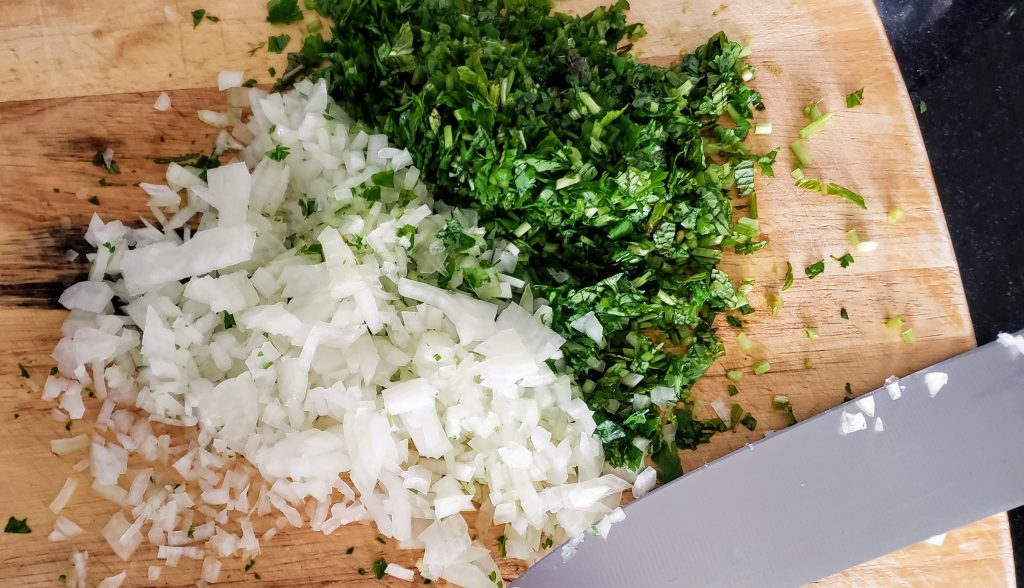
chopped onion and cilantro 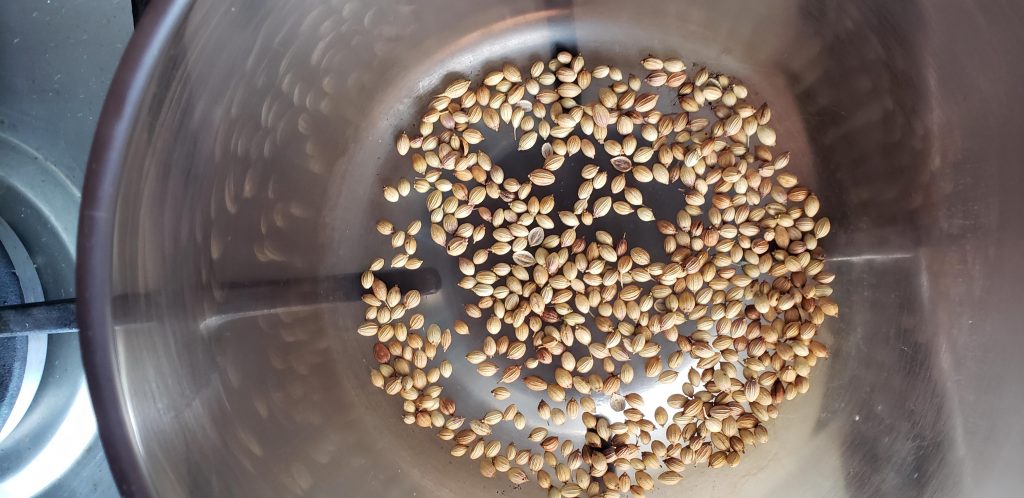
dry roasting coriander before grinding
6. Peel the cooled potatoes and grate them. Place the grated potatoes in the bowl with the chopped cilantro and onion.
7. Add the dry seasonings to the bowl and mix well. Correct the salt.
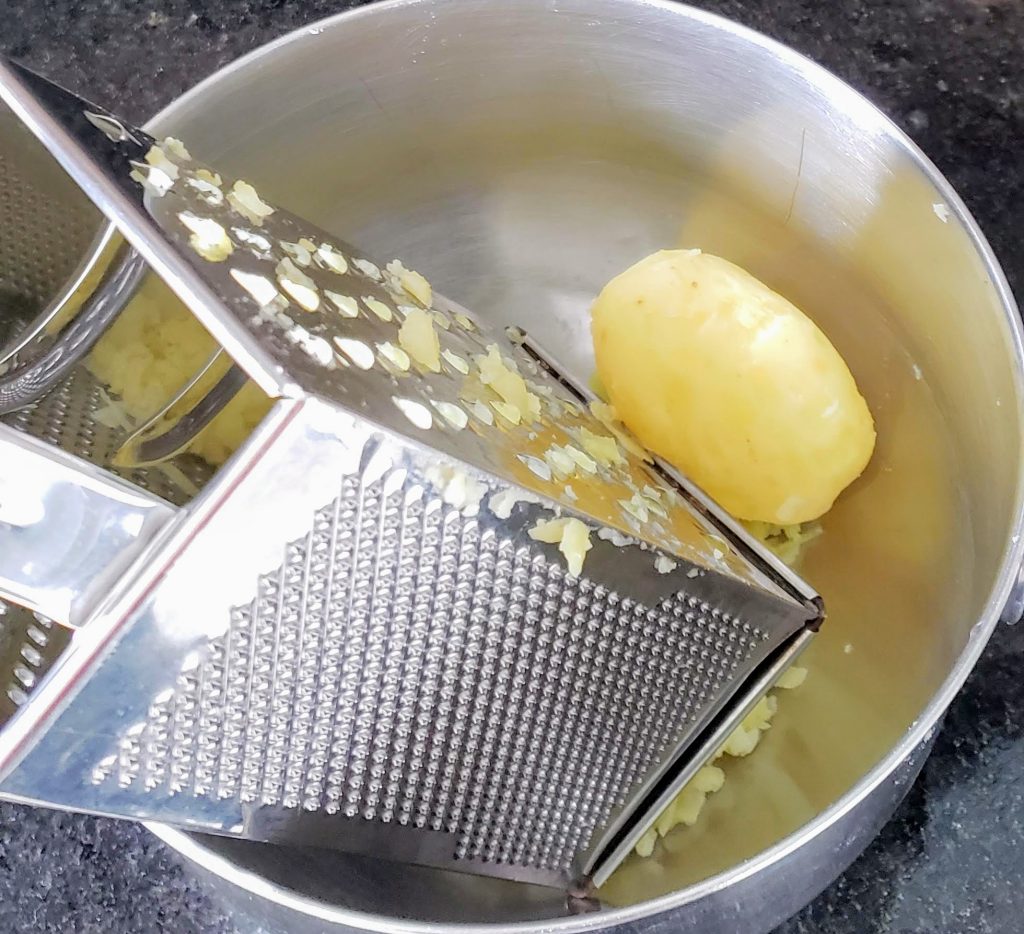

grated potato 
8. Now you are ready to roll.
ROLLING OUT THE PARATHA
1. Set up the area for rolling out the dough by placing the workspace near the Tava, or skillet or griddle. Put 1 cup of dry flour in a container for dusting.
2. Tear off a 2-inch ball of dough and roll it into the dry flour.
3. Flatten it out into a 4-inch diameter disk with either your fingers or a rolling pin.
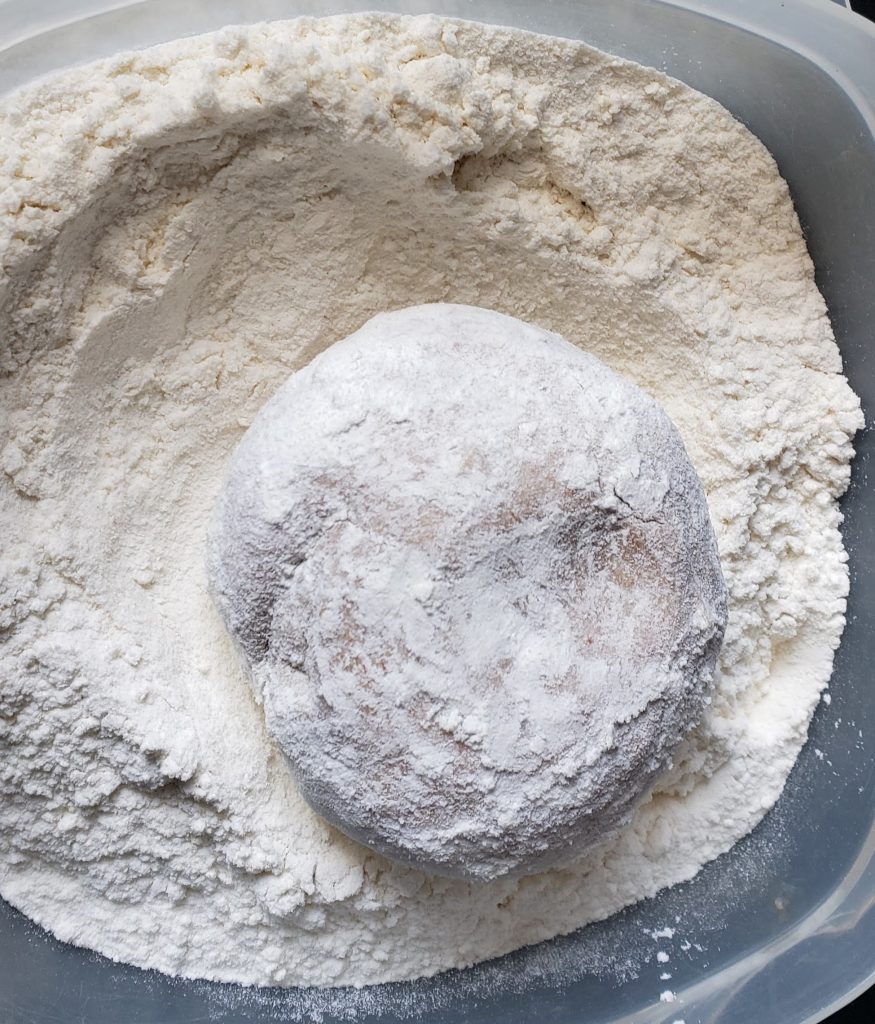
dusting the dough 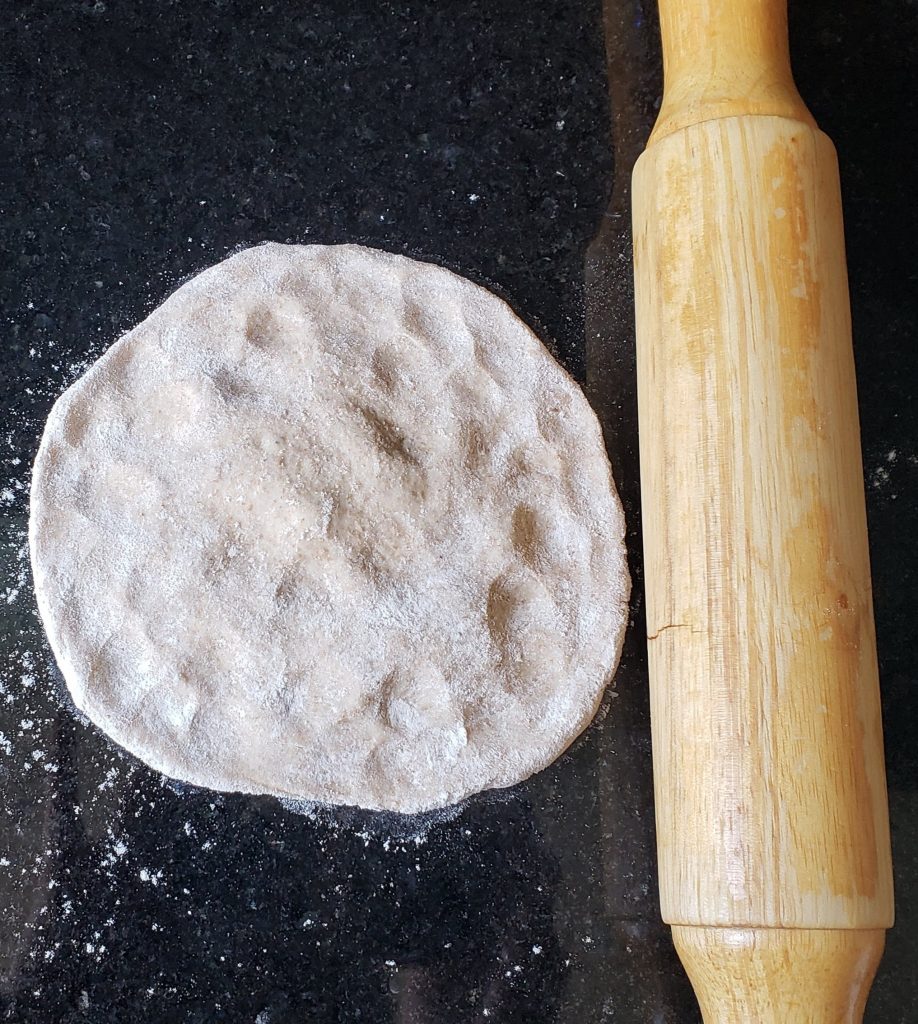
4-inch disk
4. If you are right-handed, place the disk of dough in your left palm and put 2-4 tablespoons of the filling in the center of the disk. Starting from the center of the disk, pinch the edges shut and continue until you have closed the dough completely over the filling.
5. Bring the end pieces of the semi-circle of the dough to the center and pinch them together and fold over the flap to seal.
6. The stuffed ball should now be approximately 3 inches in diameter. Place it in the dish with the dry flour and dust both sides well.

Pinching up the corners of the semi-circle 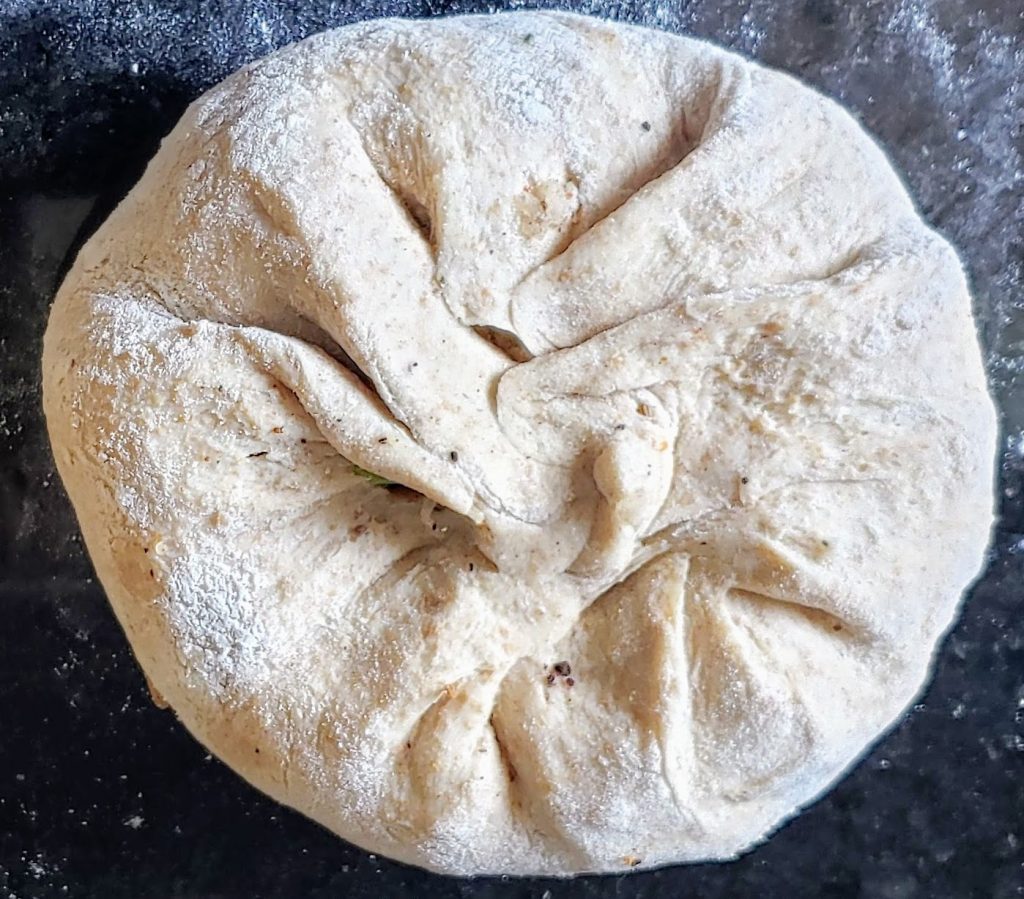
folding over the flap of dough to seal 
About 3 inches in diameter
7. Place it seam-side down on the counter and roll it out in the vertical direction until it is double in size. You must leave it seam-side down the entire time you are rolling it out; otherwise, the filling will tear the dough as the other side is thinner.
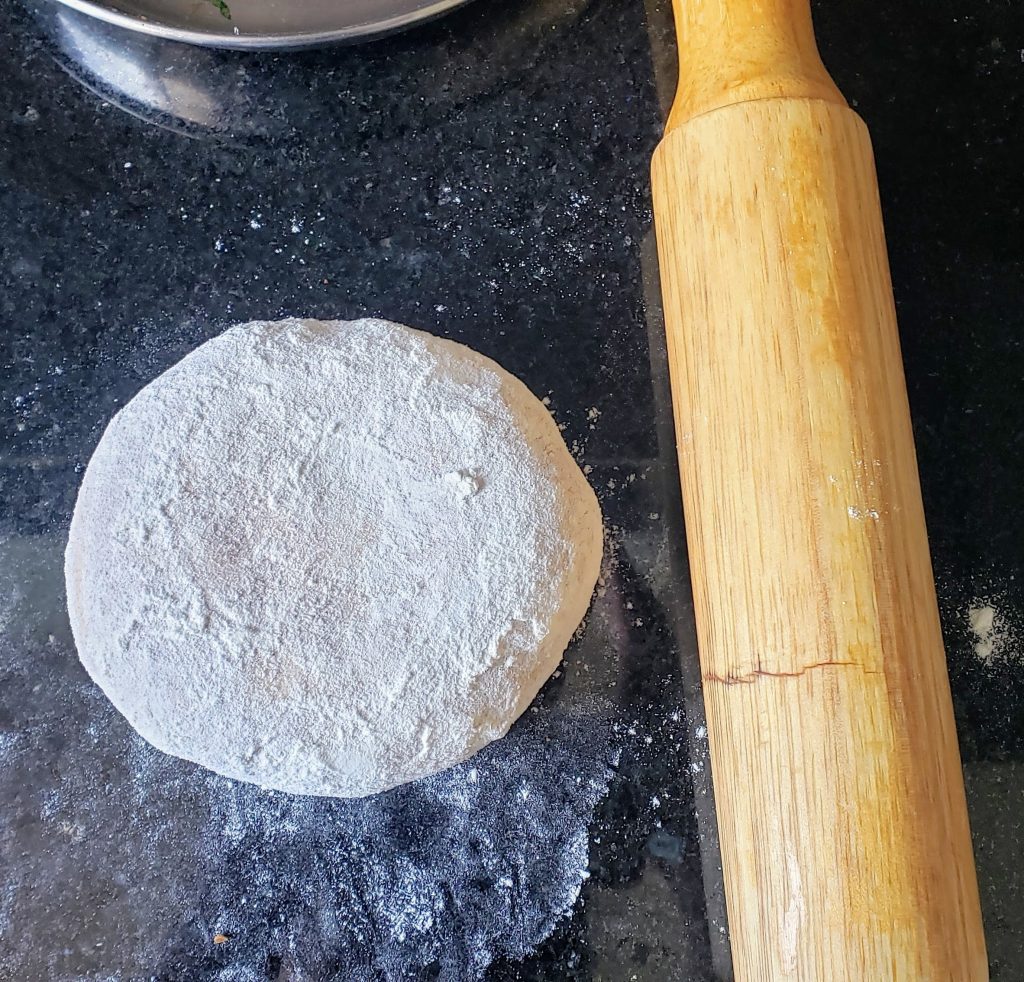
Seam-side down 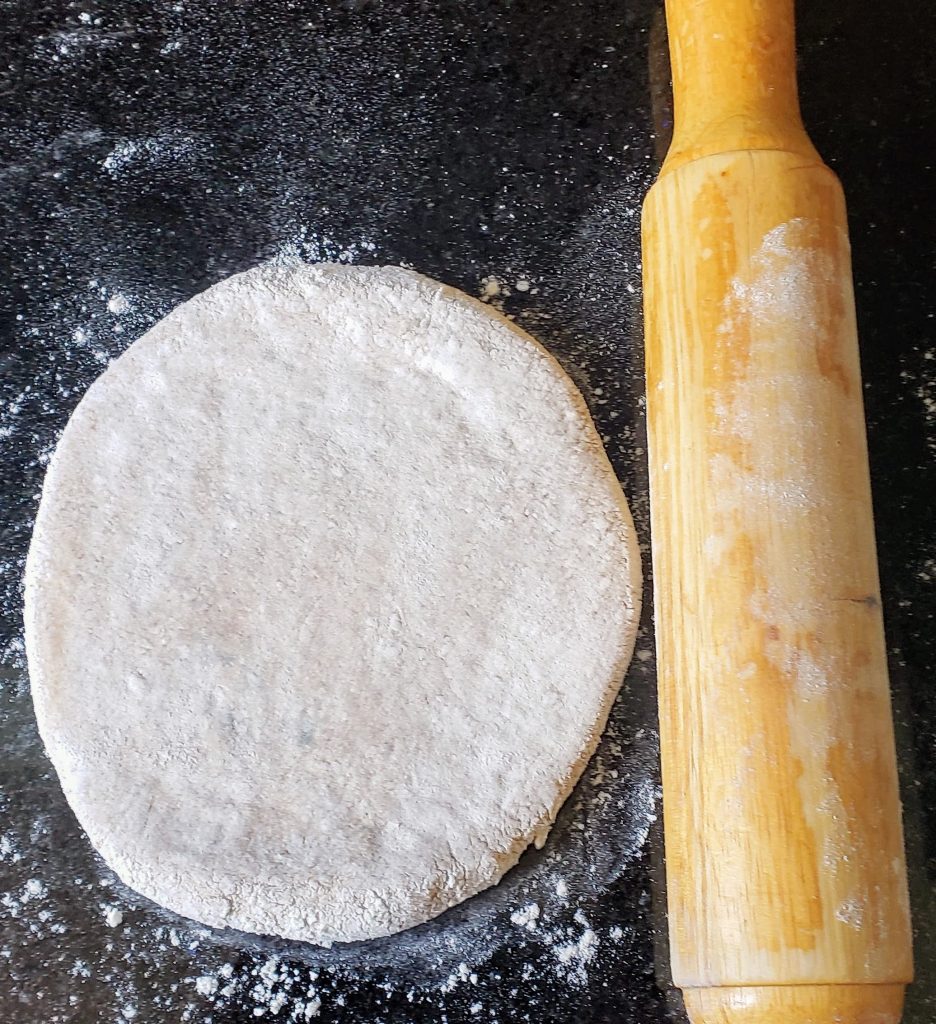
roll out to double in the vertical direction
8. Add more flour to both sides, if needed and turn it 90 degrees and roll it out again. Continue to roll it out until it forms a 7-inch diameter circle about a 1/4-inch thick.
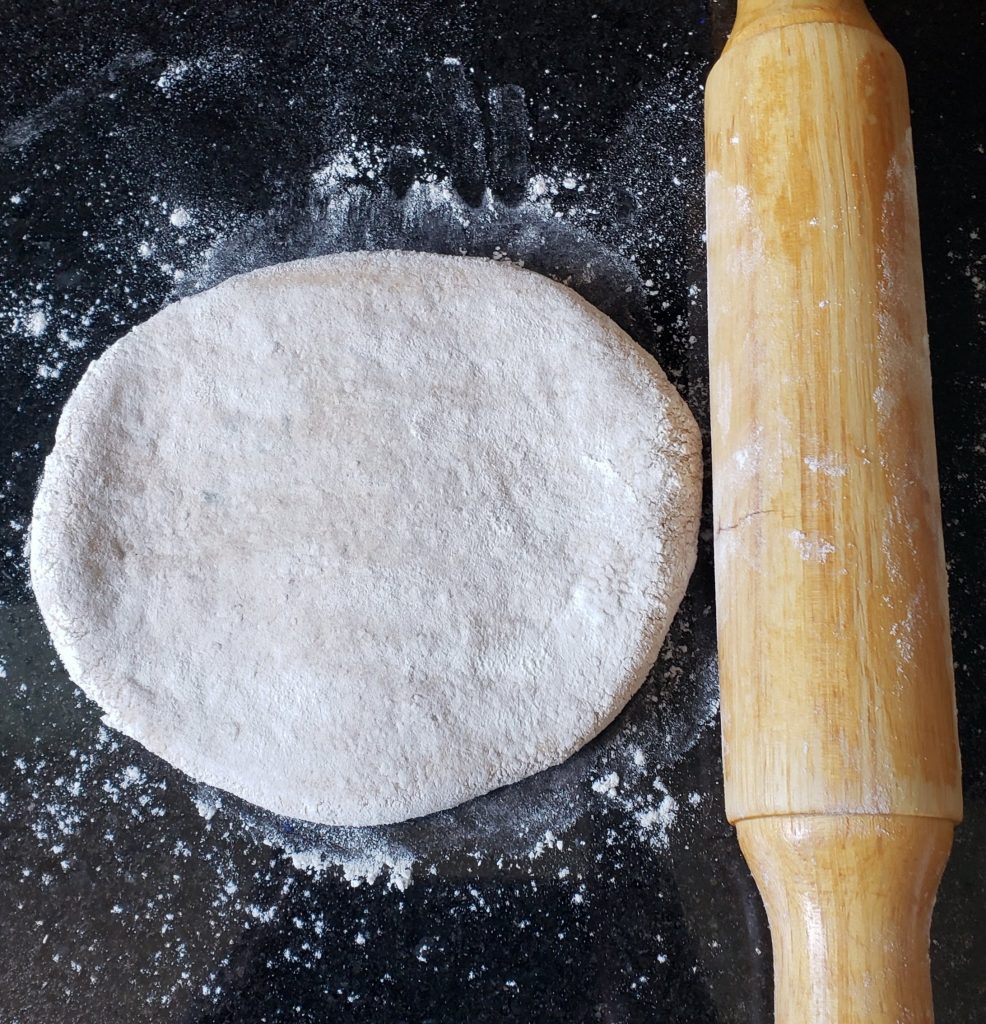
Rotated 90 degrees 
rolling out in the vertical direction 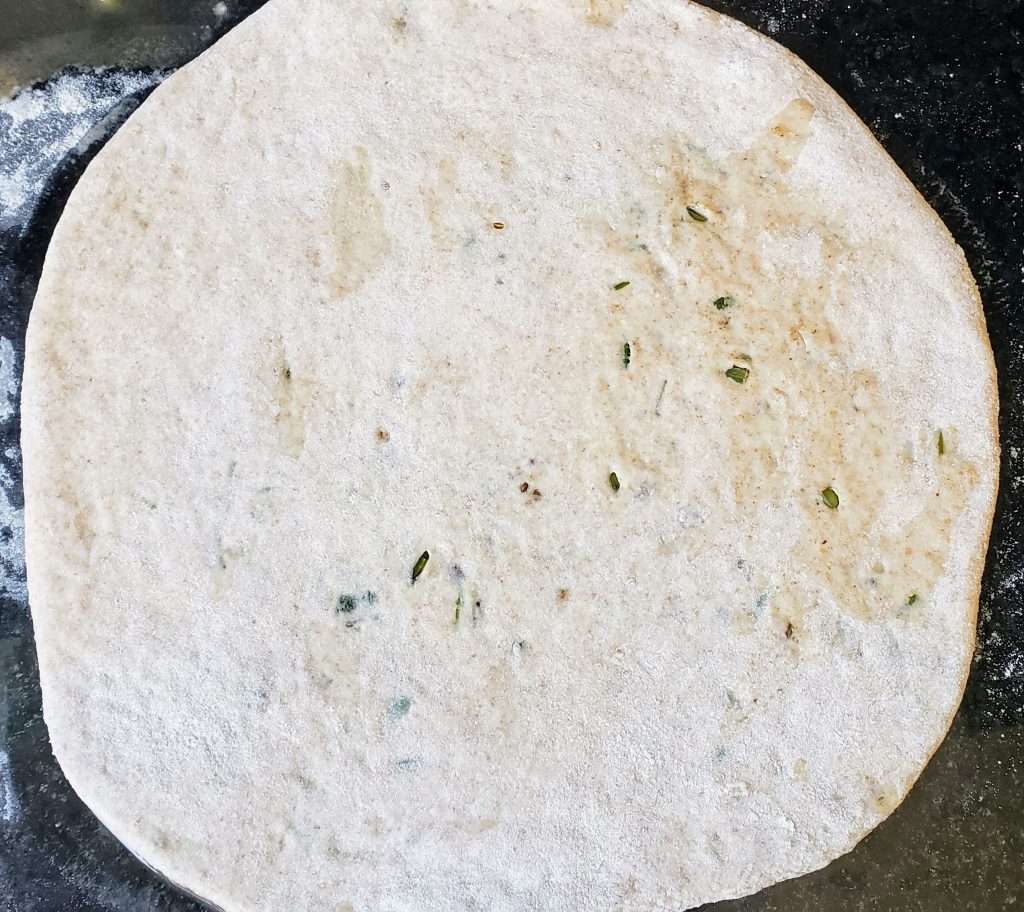
7-inch circle with a 1/4-inch thickness
COOKING THE PARATHA
1. Heat up the Tava, or large cast-iron skillet, or griddle, or large non-stick skillet over medium-high heat.
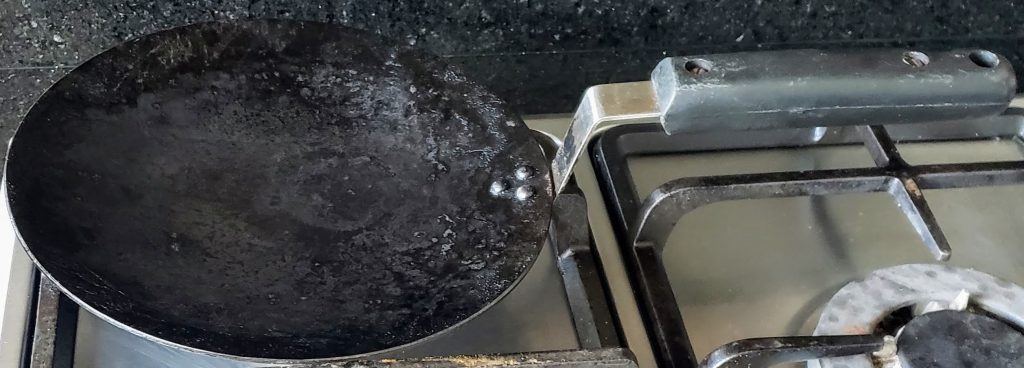
Tava
2. Lightly dust the top of the paratha with flour and fold it in half. Pick up the semi-circle of dough and place it on the hot pan and unfold it back to a circle.

Fold over rolled Paratha to ease transfer to Tava 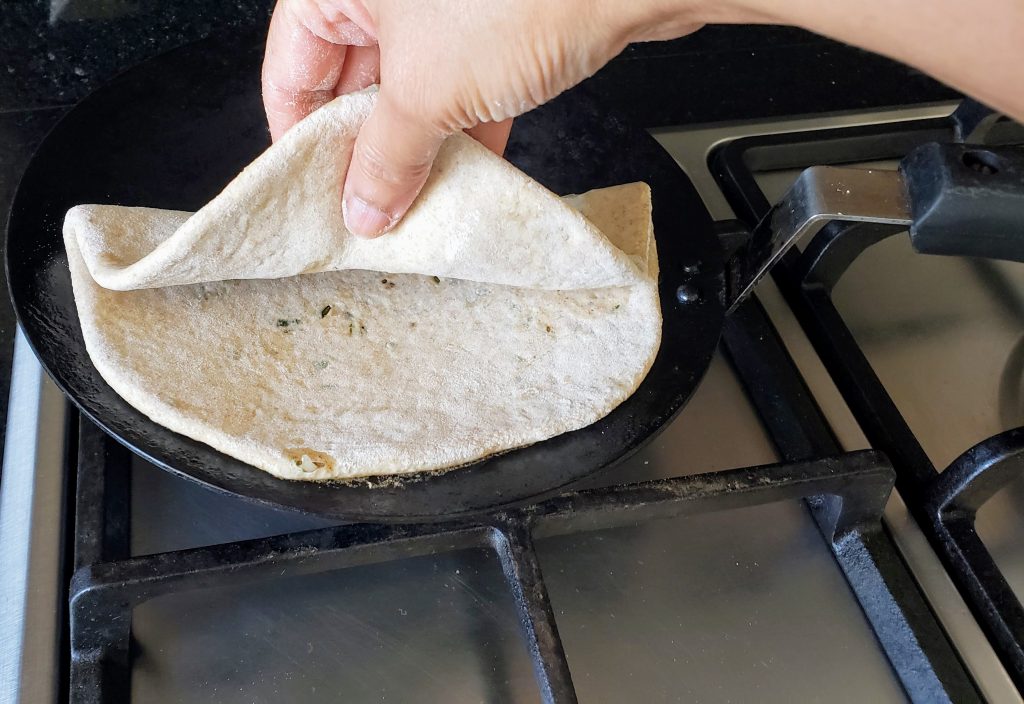
Place it on hot Tava 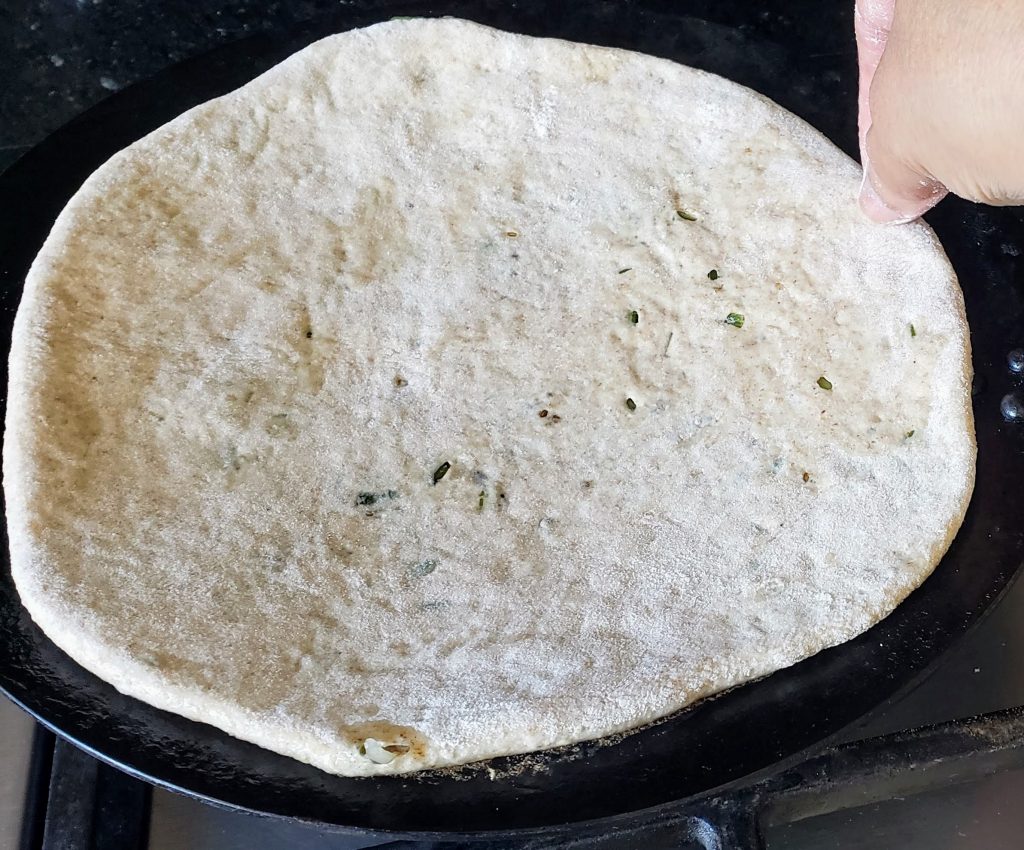
Unfold for cooking
3. Let the paratha cook for about 1 1/2-2 minutes on one side and flip it. You can tell if it is ready to turn over by observing the edges of the dough. The paratha will appear drier at the top and the dusting of flour will not be present at the very edge as it cooks.
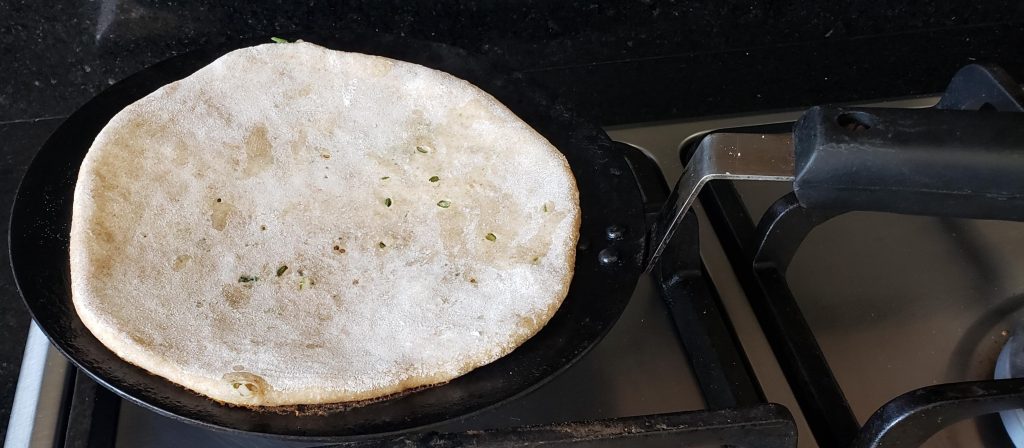
Paratha appears dry on top 
No dry flour appears on the outer edge 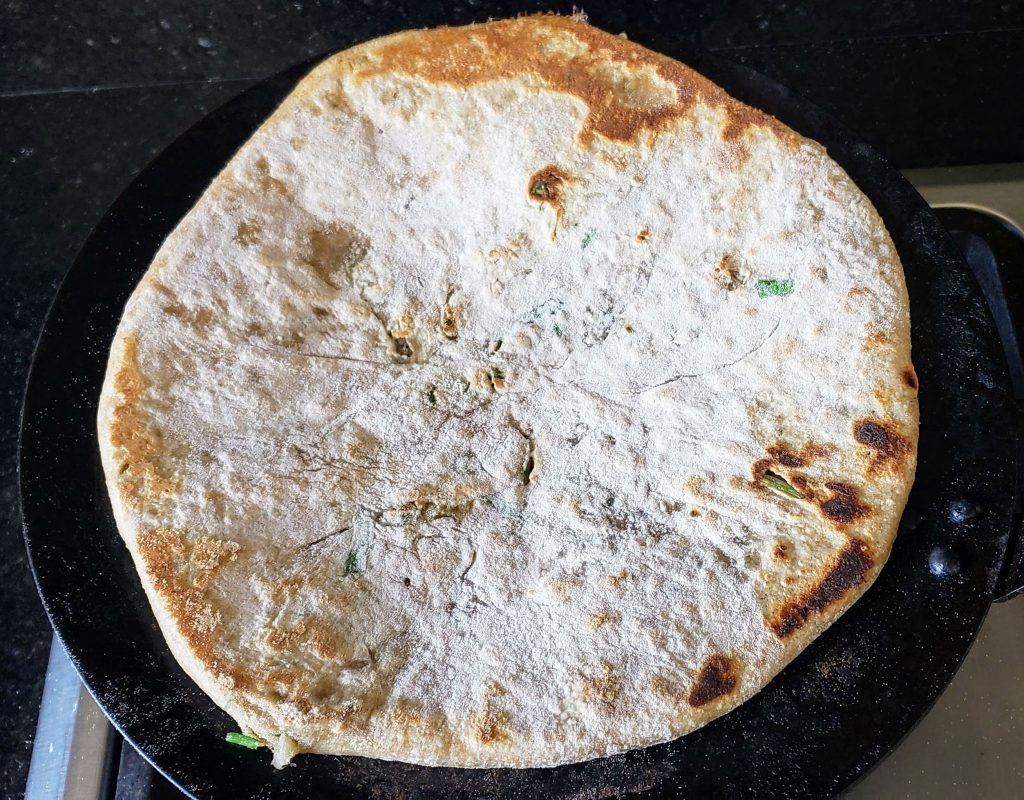
Perfectly cooked on the bottom
4. Let it cook for 2 minutes on the other side or until it is lightly dotted with brown spots. You don’t want to burn it. You may need to reduce the heat if you see scorching.
5. It is up to you, you can add a light coating of Ghee or oil to this side or leave it dry as I do.
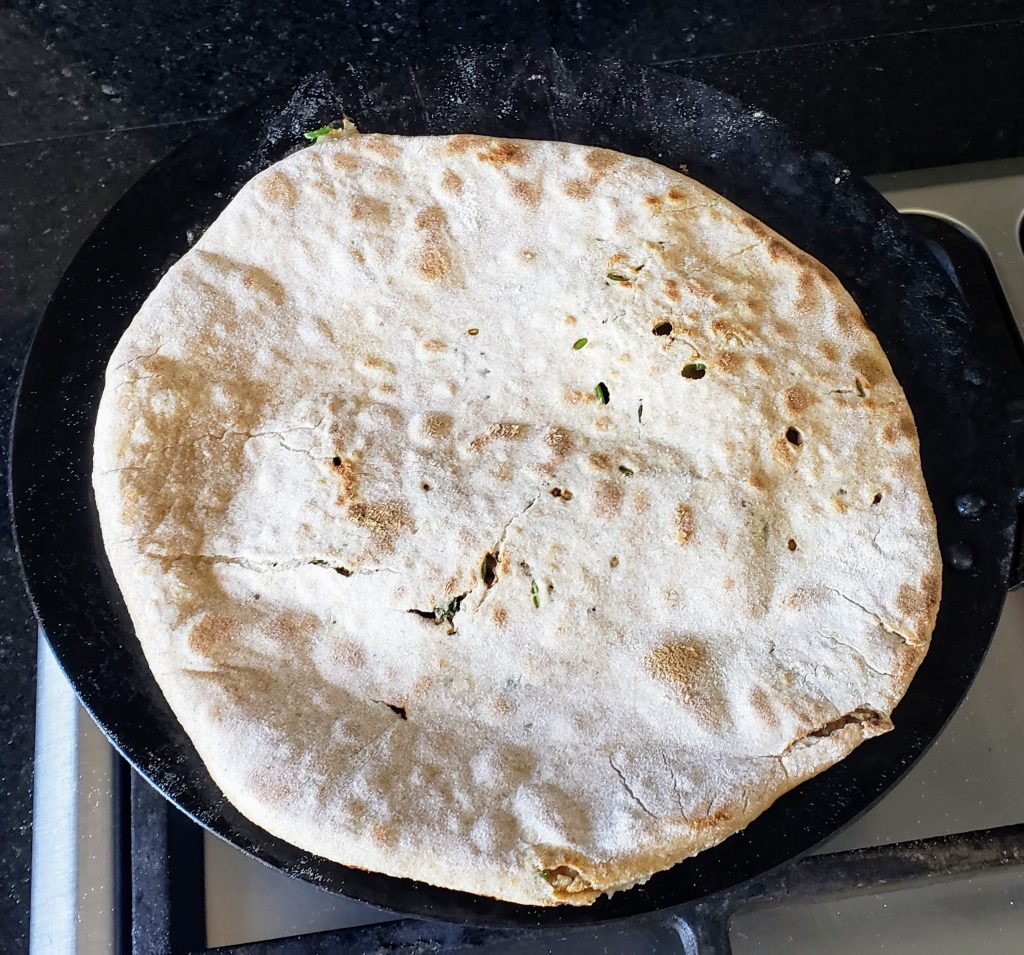
Brown dots indicate well cooked
6. Flip it back to the first side and continue to cook for another minute.
7. Again, it is up to you, you can add a light coating of Ghee or oil to this side or leave it dry as I do. However, if you do add the ghee, flip it again and cook it for a few seconds before removing it onto a plate for serving.
8. Eat it piping hot with a pat of butter and/or a cup of plain yogurt for dipping and/or a side of pickle.
Aside: Any leftover dough or filling can be refrigerated in separate sealed containers for up to a week. Leftover dough can also be frozen.
Note:*These ingredients may be purchased at your local Indian grocer. For this reason, I have given you the name of the spice both in English and Hindi as that is the name (written phonetically in the English alphabet) you will find it under when you go shopping.
Spices impart specific flavors and aromas that enhance the overall flavor of the dish when used correctly. Moreover, they have a lot of health benefits. The list below specifies:
- The name of the spice;
- The flavor(s) it imparts;
- How and when it may be used; and, finally,
- It’s health benefits.
Dried Pomegranate seeds (anardana) – Sour, fruity. If using it in the powdered form to season cooked food, add it after the burner has been turned off. Used whole or in powder form to season vegetable stuffings when making flatbreads (Parathas) or savory pastries (Samosas and Kachoris). Used to season boiled, dry bean dishes (kale chole) and potato and vegetable cutlets (Tikis). Made into candy and eaten. Natural aphrodisiac; lowers blood pressure; improves heart health; and, improves memory. It contains punicic acid, an Omega-5 fatty acid that helps fight breast cancer.
Cayenne pepper – Spicy, sharp. Added directly after the dried whole spices either in its fresh or powdered form. When using its whole, dried form, add it in the middle when seasoning the oil. Minced and mixed in Chaat and bean salads or used whole, as a condiment or in a mixed vegetable salad. Hot peppers are often eaten as pickles. Powdered, whole dried, or fresh minced chili peppers are used in cooking and added directly after the dried spices to season the cooking oil., Hot peppers have anti-bacterial; anti-fungal; anti-inflammatory; and, anti-oxidant properties. It helps fight the cold/flu; reduces joint pain; improves metabolism; promotes weight loss; and, is rich in vitamins A, B6, C, K1, and minerals like potassium and copper.
Dhania (fresh coriander) – Citrus-like, Soapy. Either you’ll love it or hate it. Both leaves and stems are used as a condiment and added to food at the end of cooking as decoration, an aromatic and a flavor enhancer. It is used all over Asia and in Latin America. It is made into chutneys and salsas. It is chopped and added to salads. It is baked as part of stuffing into bread such as parathas. It is added to vegetarian and meat dishes alike. Coriander may protect your heart by lowering blood pressure and LDL (bad) cholesterol while increasing HDL (good) cholesterol. It is an antimicrobial, antioxidant and reduces the symptoms of Irritable Bowel Syndrome such as bloating or gas.
Sooka Dhania (coriander seeds) – Smoky (if left whole) and sour (if ground). It is added in its split form to the cooking oil in the middle of the seasoning process. If using it in the powdered form to season cooked food, add it after the burner has been turned off. Used in powder form to season vegetable stuffings when making flatbreads (Parathas) or savory pastries (Samosas and Kachoris). Used roasted and coarsely ground to season cooking oil in vegetarian and meat gravies. Ground into a powder and used at the end to layer flavor in both vegetarian and meat dishes. It is one of the components of Garam Masala. Whole seeds are boiled into a tisane to relieve menstrual cramps during heavy flow. High in fiber and aids in bowel movement; promotes insulin production. Rich in copper, zinc, and iron and vitamins K, C, and B which are good for healthy skin and hair. It assists in weight loss and reduces body fat. FYI, plant coriander seeds to get fresh coriander plants.
Written by Anju Kapur of Anju’s Table. All content and images on this site are copyright protected. Please do not use any of my images without my permission. Should you wish to share this recipe on your site, please add a link to this post as the source.



[…] Boiled, grated potatoes prepared the same as above without carom seeds – Aloo Paratha. […]
[…] Cook Channa Dal (pigeon peas) with very little water so that it retains its shape. Then, continue to cook to dry off any remaining water, season it, and use it as a filling much like Aloo Paratha; […]